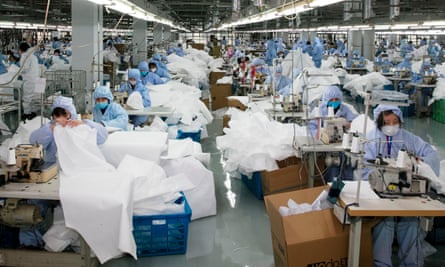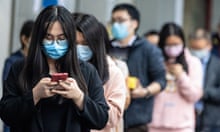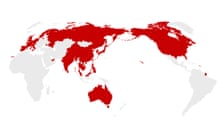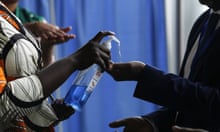The number of deaths and infections caused by the coronavirus in China has risen sharply after authorities changed the way they calculated the figures amid a purge of party officials in the stricken province of Hubei.
On Thursday China confirmed 254 additional deaths – the majority of them in Hubei, the centre of the outbreak, bringing the total death toll to 1,370. After days of declines in new infections, Hubei province reported an enormous increase of almost 15,000 – a jump of about a third on the total so far.
Hubei’s health commission said it was now including in its confirmed tally those people diagnosed via CT scans as well as via testing kits. Previously, the authorities had included only those cases confirmed by the diagnostic testing kits, which are in short supply. The change has been applied only to Hubei province.
In other developments on Thursday, Japan recorded its first death and Vietnam placed 10,000 people under quarantine after six cases were discovered in a cluster of villages – the first such lockdown overseas.
The change in China to include what are known as “probable cases” appeared aimed at heading off complaints about the availability of tests and treatment for residents, as well as questions about whether officials have been underreporting cases.
The shortage of the testing kits has meant that many sick residents have been unable to seek treatment, with hospital admission contingent on the test result. Health workers have been calling for authorities to broaden the parameters for diagnosing in order to treat more patients. Some have also questioned the reliability of the tests.

The political fallout from the outbreak also escalated on Thursday with the firing of party chief of Hubei province, the party chief of Wuhan and the head of China’s Hong Kong and Macau Affairs office. Ying Yong, the new party chief of Hubei, came up through the ranks in Zhejiang, where the president, Xi Jinping, previously served as party secretary and was also part of anti-corruption campaigns, the president’s signature initiative.
“This is clearly Xi’s move,” said Dali Yang, a professor of political science focusing on China at the University of Chicago. “The stakes are high and he needed time to find the right people for the positions to salvage the Hubei, Wuhan situation,” he said.
On Wednesday, the state-run China Daily news site reported that a powerful Beijing official parachuted into Wuhan to supervise the fight against the virus had reprimanded local officials for failing to organise treatment quickly enough for people reporting to hospitals with symptoms of the illness.
Thursday’s jump in infections may have been another impetus for the purges. “I suspect Xi would have wanted the personnel change to project a sense that he is in control of the situation. The bad numbers undermine that message,” said Sam Crane who teaches Chinese politics and ancient philosophy at Williams College.

In Shiyan, a city in central Hubei, the authorities have instituted “war-time measures”, where only those actively involved in fighting the virus are allowed to leave their homes. From Thursday, all buildings will be sealed. Residential areas will also be sealed and put under 24-hour watch. Public security will enforce the measures.
Victor Shih, a specialist in Chinese politics at the school of global policy and strategy at University of California San Diego, said the switch in methodology was “disturbing”. “The adjustment of the data today proved without doubt that they have had two sets of numbers for confirmed infected all along,” he said.
Paul Hunter, Professor in Medicine at the University of East Anglia, said the World Health Organization seemed also to be at a loss. “It is notable that WHO has not updated its dashboard with Chinese figures today, suggesting to me that they have not yet decided how to deal with this,” he said.
The crisis also deepened in Hong Kong, where the education minister announced that schools would remain closed until at least the middle of March. They have been closed since the start of the lunar new year at the end of January.
In Vietnam, the authorities announced the lockdown of the commune of Son Loi, a farming region about 25 miles from Hanoi, for 20 days. Checkpoints were set up around the commune and health officials wearing protective suits sprayed disinfectant on vehicles.
In Japan authorities announced the first death of a person infected with virus, making it the third outside mainland China after the Philippines and Hong Kong. However, it was not clear if the woman in her 80s had died because of the virus or other complications, the Japanese health minister said.
The biggest cluster of cases outside China is on a cruise ship quarantined off Japan’s coast, where 44 more people tested positive for the virus, raising the total number of infections on the Diamond Princess to 218.
In Cambodia, passengers on a cruise ship that spent two weeks at sea after being turned away by five countries over fears that someone aboard might have the coronavirus cheered and clapped as the vessel finally arrived at port.
The MS Westerdam, carrying 1,455 passengers and 802 crew, docked in Sihanoukville in the evening after anchoring offshore early in the morning to allow Cambodian officials to board the vessel and collect samples from passengers with any signs of ill health or flu-like symptoms. Disembarkation is due to take place on Friday.
As UK health officials prepared for more cases of the virus after the first confirmed sufferer in London, US officials said a second case had been confirmed in San Diego.
The person was an evacuee from Wuhan and was among 232 people placed under quarantine at the Marine Corps Air Station in Miramar after being airlifted from Wuhan.
Reuters contributed to this report







